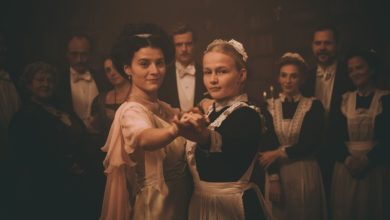The 10th Muse on LIFT
In this short but focused montage you’ll get to know a film club whose organizers cater to the lovers of the lesbian/feminist genre. And they don’t only screen these films: ever since they’ve started there is an order in their choices from month to month. And in the seventh row there sits the tenth muse and you can almost feel the presence of a great actress as well. To get a sense of how it works you can now get a glimpse into the inner workings of the Gobbi Hilda Film Club.
How it all started
The story goes like this: the Gobbi Hilda Film Club, a monthly program of Labrisz Lesbian Association, started in 2006. Bea Ledényi, the owner of Vis Major Café (and award-winner of the 9th LIFT), came up with the idea to screen the films of the Budapest Lesbian Film Committee. Bea thought this would be a one-off event but Mari (director Mária Takács, founder of the film club) misunderstood her idea – since the Film Committee had more than one film – and a series was born. This was the first season of the Gobbi Hilda Film Club.
You might be wondering about this Film Committee so we might as well stop for a moment to introduce them a bit more. The Budapest Lesbian Film Committee was founded in 2000 when their first film What should a young lesbian do in the big city? was finished. Other amateur filmmakers joined the Committee after the début and smaller creative groups were formed. Everyone could be director, camera man, editor or actor and they could also translate the films to English if they wished. Their films appeared in the repertoire of the Hungarian Gay and Lesbian Festival and even at European and American lesbian film festivals. The Committee has cooperated with Labrisz Lesbian Association since its foundation, enriching the Labrisz Lesbian Archive. Although the group had gone into hibernation for the last few years, many of the members still make films and, according to the community and their audience, their films enrich and strengthen the identities and lives of lesbians living in Hungary today.
The Second Scene
By that, I mean season. It started the following year and lasted until 2014, as Vis Major Café became the regular place for the Gobbi Hilda Film Club. But since Vis Major was closed, Kalicka Bistro became their new home.
The way it works is that on the first Saturday of every month the film club screens lesbian and/or feminist films. The choices fall on films that might be interesting for the audience either because of a character, an idea or because it’s a historical piece. But each screening is more than just about watching a film.
A film itself or the screening of a film can lure in film lovers and bring those interested in a certain topic together, but an important part of this club is the discussion after the film, when invited speakers discuss the film, its background and its social message with the leadership of a moderator. And it’s even better if the audience joins the discussion which is usually the case. And since the Club is an open event, not only women and not only gay people come, so everyone can become a part of the discussion which helps us compare different viewpoints.
Thus, the Gobbi Hilda Film Club is not only a community event, its other role is to dissolve certain boundaries with the help of films and discussions.
Gobbi, Hungarian film and lesbians
While the Club’s namesake enjoyed a very good relationship not only with the Hungarian theatre but also with the Hungarian film industry, the Film Club’s situation is not quite so bright. One thing immediately becomes clear about the films they screen: they’re foreign. Almost all of them.
Why are there no lesbian feature films, even though there’s no such thing as taboo on the screen anymore? This is why foreign opinions can grow in number. Yet in Hungary you still only find specifically lesbian films sporadically. Even lesbian plot lines are scarce in Hungarian films and TV series. Could it be that this is still a taboo in Hungary? Can it be that film and series writers don’t know what to do with a lesbian character? They’re especially bad at simply seeing them as women, or using them as the heroines of films. So even if a lesbian character does appear on screen it presents an image of lesbians usually distorted by the media, strengthening stereotypes. As if the whole thing was nothing more than the pornographic product of pop culture. Or excessive appearances: some kind of fashion element to lure in the audience.
It would be best to change this public presentation, because we’ve only looked at each other once in a Hungarian film. (And what a look that was!) Yet the celluloid didn’t burn out.
Visible Lesbians
So let’s take this again, in extreme long shot. I mean let’s see this in a world-wide context. If we think about Western societies the situation doesn’t look so gloomy. They’ve had lesbian characters both in films and television shows for a long time. Obviously not to such a degree as heterosexual women (and heterosexual women don’t appear as much as male characters but that’s the topic of a different article). But they’re definitely there. And sometimes these films are not about how much, in what ways and why the women are lesbians but about the fact that they’re people, (everyday) heroes who by the way happen to be lesbians as well. As I said: sometimes. But the fact that this is on screen, that it’s visible and natural, helps the acceptance of lesbian women.
In addition, more and more well-known actresses, media celebrities come out as lesbian or bisexual, which also helps gay people’s acceptance. One such coming out can give enormous strength to those who had not yet dared to come out, thinking: if the lesbian on the big screen could do it then so can I.
This is what the Gobbi Hilda Film Club presents on the first Saturday of every month. Visible women and visible lesbians – not only for lesbians and not only for women. In the usual time and place, next time in December.
But – to come back to our starting point, the title, after this detour – the tenth muse has a place in LIFT as well. The Film Club screens two films during the Festival.
The feature film on Friday night, S&M Sally features BDSM as its main topic and it caters to the lovers of easy genres right after the opening ceremony. Somewhat unusually, there will be no discussion afterwards (unless we discuss it over a game of cards during the Queen of Spades Game Club). What to expect? Just imagine the stumbling it might cause when our self-expectations and our self-image collides with stereotypes about other sexual minorities and with the need to conform to their expectations. This film is for those who enjoy lovely but lame heroes, piquant styles, classical and burlesque elements and for those who are at least capable of laughing – even at themselves.
The film on Sunday is an exciting Canadian documentary. Lesbiana presents the lesbian movement that went down parallel with the feminist movement. As usual, there will be a discussion after this film, and to make it that more special, the director of the film will participate as well.
Author: Mihu
Translation: Rhyenna
The online program booklet of this year’s LIFT (in two languages): http://www.labrisz.hu/10-lift-programfuzet
For more information on the organization of LIFT and details about each workshop see the Facebook page of the festival: https://www.facebook.com/liftfesztival
The photos are from the Labrisz Archive, from the Gobbi Hilda Film Club discussions, the Gobbi Hilda memorial, and from the shooting of the Lesbian Film Committee.










